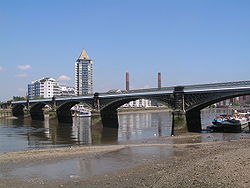Battersea Railway Bridge
Battersea Railway Bridge | |
|---|---|
 Battersea Railway Bridge from the south west | |
| Coordinates | 51°28′24″N 0°10′48″W / 51.4734°N 0.179901°W |
| Carries | Railway |
| Crosses | River Thames |
| Locale | London, England |
| Heritage status | Grade II* listed structure |
| Preceded by | Wandsworth Bridge |
| Followed by | Battersea Bridge |
| Characteristics | |
| Design | Arch bridge |
| History | |
| Opened | 2 March 1863 |
| Location | |
 | |
The Battersea Railway Bridge - properly called the Cremorne Bridge, after the pleasure grounds in Chelsea and originally commonly referred to as the Battersea New Bridge - is a bridge across the River Thames in London, between Battersea and Chelsea and forming part of the West London Line of the London Overground from Clapham Junction to Willesden Junction.
History

The bridge was designed by William Baker,[1] chief engineer of the London and North Western Railway, and was opened on 2 March 1863 [2] at a cost of £87,000.[3] It carries two sets of railway lines and consists of five 120-foot (37 m) lattice girder arches set on stone piers.[4]
There is a three-arch brick viaduct on the north side of the bridge, with one arch having been opened to provide a pedestrian route under the railway, as part of the Thames Path. On the south side there are four arches, two of which are used as storage for the residents of a houseboat community located immediately downstream of the bridge.[4]
The bridge was strengthened & refurbished in 1969, and again in 1992. During a high tide in late 2003, the structure was struck by a refuse-barge, and some of the lower structural elements damaged significantly: repairs were completed in early 2004.[5]
In 2013, planning permission was granted for the Diamond Jubilee Footbridge directly upstream from Battersea Railway bridge.
Trains crossing the bridge are subject to a 20/30 mph speed limit (locomotive-hauled traffic is restricted to 20 mph, all other traffic is limited to 30 mph).[2]
The bridge was declared a Grade II* listed structure in 2008, providing protection to preserve its special character from unsympathetic development.[6]
See also
References
- ^ London bridges images and info (website)
- ^ a b Battersea Railway Bridge Tour UK (website)
- ^ "Battersea Railway Bridge". Where Thames Smooth Waters Glide. Retrieved 15 December 2013.
- ^ a b "River access supports Battersea Bridge refurb". Maritime Journal. 24 June 2013. Retrieved 15 December 2013.
- ^ "Inspection Report Detailed Bridge Assessments Sub-Package 2A" (PDF). Retrieved 15 December 2013.
- ^ London bridges get listed status (BBC News) accessed 26 November 2008
Further reading
- Loobet, Patrick — Battersea Past, 2002, p49. Historical Publications Ltd. ISBN 0-948667-76-1
External links
- Railway bridges in London
- Bridges completed in 1893
- Buildings and structures in Kensington and Chelsea
- Buildings and structures in Wandsworth
- Transport in Kensington and Chelsea
- Transport in Wandsworth
- Bridges across the River Thames
- Bridges and tunnels in London
- London Overground
- Grade II* listed buildings in London
